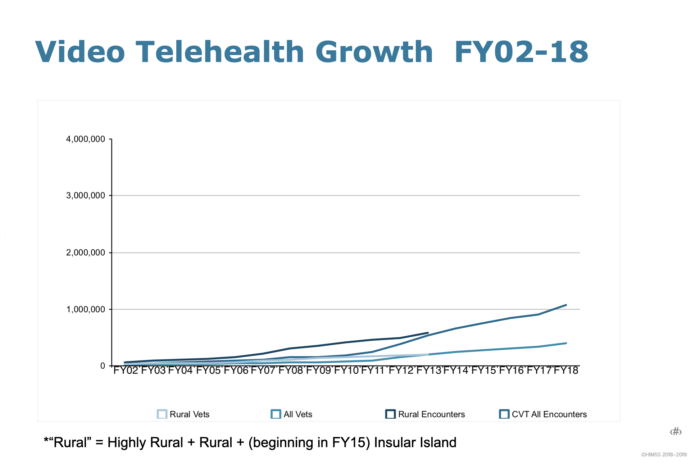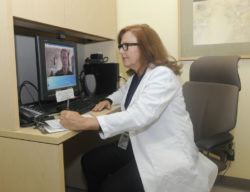WASHINGTON.—VA Secretary Robert Wilkie announced new partnerships with several prominent companies and veterans’ organizations to make access to health services easier for veterans, regardless of their location. Collaborators announced at the recent Anywhere to Anywhere, Together summit include Walmart, Philips, T-Mobile, Verizon, the American Legion and Veterans of Foreign Wars.
“These types of events will help accelerate our shared journey to fully-integrated, seamless access to healthcare, no matter where a veteran resides,” said VA Secretary Robert Wilkie. “Indeed, from anywhere to anywhere.”
The announcement comes on the heels of a record-breaking year for telehealth within the VA. Veterans received care through more than one million telehealth visits in fiscal year 2018, a 19% increase over the previous year.
Even so, video telehealth visits with providers represented less than half of the total 2.29 million episodes of telehealth care provided by the VA in FY 2018, said Neil Evans, MD, chief officer of the VA’s Office of Connected Care. The balance of the encounters included images sent to VA staff by a veteran or staff at another location and remote monitoring of patient data.
Overall, 13% of veterans who received VA care last year did so through telehealth, which now includes more than 50 specialties. Of the 782,000 patients who used the three remote modalities, more than 45% lived in rural areas, according to the VA.
Taken together, the expansion of telehealth services has made accessing VA care significantly easier for all veterans, especially those in remote or isolated locations. “VA’s telehealth capabilities are bridging the care gap for many veterans,” Wilkie said. “This technology gives veterans access to the timely, quality care they deserve, without having to travel great distances to a VA facility.”
Each of the new partners brings specific advantages to the Advancing Telehealth through Local Access Stations program, which aims to overcome the digital divide between veterans with high-speed internet access and those without.

A Local Spot
“Not every veteran has the technology at home to access their providers remotely,” said Kevin Galpin, MD, executive director of the VA’s Telehealth Services. “A lot of people have internet but still can’t fully access telehealth services. They may lack access to high speed internet or sufficient mobile data.”
The Walmart partnership will give veterans a local spot to connect with their providers remotely. Walmart will set up spaces in five stores, where veterans can get the type of services they would otherwise be able to get in home if they had internet access, Galpin said. While the locations have yet to be announced, they will be in “communities with a high density of veterans without a nearby VA medical facility,” he noted.
The American Legion, VFW and Philips also will work together to expand access for providers in more rural locations. The veterans’ organizations will provide space for veterans to participate in telehealth visits in their posts. Philips will provide the medical equipment, including video screens, electronic scales, blood pressure cuffs, thermometers, glucose monitors and other tools, all connected to the VA system via a secure, high-speed internet line. The locations are expected to open early this year and will be in Idaho, Montana and Wyoming.
“The T-Mobile and Verizon partnerships are another step in overcoming the digital divide,” Galpin told U.S. Medicine.

Instead of providing a central location to receive remote care in a community, the mobile carriers will make it easier for many veterans to use telehealth without leaving home. The partnerships make “an important statement to veterans that people really support their healthcare and want them to get the services they need,” he added.
The mobile carriers have agreed to essentially donate data to veterans so that their customers can use VA Video Connect without the data used counting against data caps or incurring charges. “It’s not just the veterans who can use the data, but caregivers as well,” Galpin explained. The partnerships will “better connect caregivers and families who might be coordinating through cellphones at home. Now they can do that without worrying about data charges or limiting plans.”
“These partnerships are part of the VA commitment to bring telehealth closer to veterans,” Evans told U.S. Medicine. “The VA Video Connect program allows for simple videoconnections for veterans and caregivers with the care team through any technology that has internet access, a webcam and speaker.”
The new partnerships advance the “VA goal of providing the right providers at the right time at the right place to care for a veteran in any location,” according to Galpin. While every area can be augmented by virtual care, the VA’s “first goal is to make all primary care teams and mental health teams video available and to have all of the infrastructure in place by the end of 2020 for those teams,” he said.
Evans emphasized that telehealth should be seen not as a standalone system but as part of an integrated healthcare system. It should be so simple for veterans, he said, that “it becomes a standard part of providing services, where the veteran has the option to say, ‘I’d like to have this visit done virtually.’”
